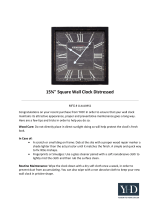
USER’S INSTRUCTION
11
COOKER CARE
Self-Cleaning Cycle
IMPORTANT: The health of some birds is extremely sensitive to the
fumes given off during the Self-Cleaning cycle. Exposure to the
fumes may result in death to certain birds. Always move birds to
another closed and well-ventilated room.
Do not block the oven vent(s) during the Self-Cleaning cycle. Air
must be able to move freely. Depending on your model, see “Oven
Vent” section.
Do not clean, rub, damage or move the oven door gasket.
Prepare Cooker
■ Remove the broiler pan, grid, cookware and bakeware, all
cooking utensils, oven racks and aluminum foil and, on some
models, the temperature probe from the oven.
■ Use a damp cloth to clean inside door edge and the 1½"
(3.8 cm) area around the inside oven cavity frame, being certain
not to move or bend the gasket.
■ Remove plastic items from the hob because they may melt.
■ Remove all items from the storage drawer.
■ Excess spillage must be removed before cleaning.
How the Cycle Works
IMPORTANT: The heating and cooling of porcelain on steel in the
oven may result in discoloring, loss of gloss, hairline cracks and
popping sounds.
Before self-cleaning, make sure the door is completely closed or
the door will not lock and the self-cleaning cycle will not begin.
Once the oven has completely cooled, remove ash with a damp
cloth. To avoid breaking the glass, do not apply a cool, damp cloth
to the inner door glass before it has completely cooled.
To stop the self-cleaning cycle at anytime, press CANCEL. If the
temperature is too high, the oven door will remain locked and
“cool” and “locked” will be displayed.
The oven light will not function during the self-cleaning cycle.
Electronic Oven Control with Adjustable Clean Time
The Self Clean self-cleaning cycle is time adjustable between
2 hours 30 minutes and 4 hours 30 minutes in 15-minute
increments. Under such conditions, the surfaces may get hotter
than usual. Suggested clean times are 2 hours 30 minutes for light
soil, and 4 hours 30 minutes for heavy soil. The last 30 minutes of
the cycle is for cool down.
To Self-Clean:
1. Press SELF CLEAN.
2. Press the TEMP/TIME “+” or “-” arrow keypad to enter the
desired self-clean cycle time.
3. Press START.
The oven door will automatically lock. The Door Locked and
Clean indicator lights will turn on. The time remaining will also
be displayed.
4. When the self-clean cycle is complete and the oven cools, the
Door Locked and Clean indicator lights will turn off.
5. When the oven is completely cooled, remove ash with a damp
cloth.
Steam Clean
IMPORTANT: Do not use oven cleaners or any other additives with
Steam Clean.
The Steam Clean feature is designed for light oven cavity bottom
cleaning. Use the Steam Clean feature as soon as possible after
spills occur. The longer a spill sits and dries in the oven, the more
difficult it may be to remove.
Allow the cooker to cool to room temperature before using the
Steam Clean feature. If your oven cavity is above 170°F (77°C),
“HOT” will appear in the display, and the Steam Clean feature will
not activate until it cools down.
■ Remove all racks and accessories from the oven cavity.
■ For best results, pour 10 oz (295 ml) of distilled or filtered water
onto the oven bottom.
■ The Steam Clean feature will take a total of 20 minutes. “End”
will appear in the display at the end of the cycle.
IMPORTANT: Since the water in the oven bottom is hot, do not
open the oven door during the Steam Clean cycle.
Press CANCEL at any time to end the cycle. The display will return
to the time of day.
Helpful Hints
■ Once the Steam Clean cycle is complete, remove all remaining
water and debris in the bottom of the oven with a sponge or
cloth.
■ Wipe any remaining moisture from the oven door interior, oven
cavity interior sides, and hob.
■ Use a soft brush or nylon scrubber to wipe the oven interior.
This may help with more stubborn stains.
■ If any soil remains, run a second Steam Clean cycle to help
loosen debris for easier removal.
■ Use the Steam Clean on small spills such as cheese or sauce
from pizza or snacks, or drips from casseroles.
■ Food spills containing sugar, proteins or starches may require
vigorous scrubbing to remove most of the debris.
■ It is recommended to use distilled or filtered water, as tap water
may leave mineral deposits on the oven bottom. Use a cloth
soaked with vinegar or lemon juice to remove any mineral
deposits that may be left after the Steam Clean cycle.
■ If the oven is heavily soiled, use the Self-Clean cycle. The
Steam Clean cycle may be used first to eliminate most of the
debris, resulting in a more effective self-clean.
WARNING
Burn Hazard
Do not touch the oven during the Self-Cleaning cycle.
Keep children away from oven during
Self-Cleaning cycle.
Failure to follow these instructions can result in burns.




















